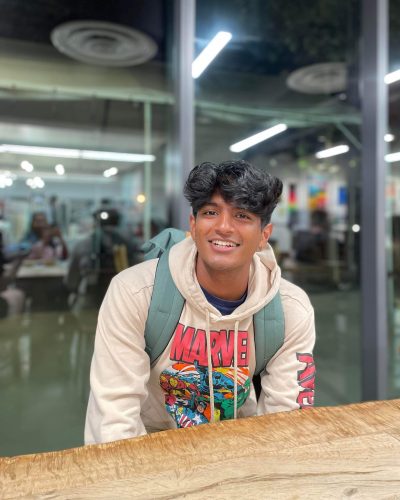
Avi Vadali started researching at Fermilab for class credit his senior year of high school. Now that work is being published in a journal article. Photo: Avi Vadali
Quantum computing is a ripe research area for aspiring young scientists, but few find themselves authoring a research publication before higher education. This was not the case for Avi Vadali, an enterprising young researcher who sought out a research position at the U.S. Department of Energy’s Fermi National Accelerator Laboratory the summer before his senior year of high school. He ultimately helped author a journal article about machine learning and quantum computing that has gone through the peer-review process and will appear in Quantum Machine Intelligence soon.
It all started the summer before his senior year of high school when Vadali decided he wanted to join a research lab. “I was really into physics; I had been doing math research up until then and wanted to explore research a bit more,” he said. So, Vadali said he started reaching out to a variety of professors and researchers, ranging from academics at universities to national labs, such as Fermilab.
Responses were few and far between, but that didn’t dissuade Vadali. He said that he remembered attending a Saturday Morning Physics lecture with Fermilab scientist Gabriel Perdue. “He presented quantum computing in a really approachable way,” said Vadali, “So I thought, ‘Yeah, I’d definitely love to work with him.’”
When Perdue got Vadali’s email, he said he was glad to hear from a student who had participated in Saturday Morning Physics. The 11-week long program connects students with researchers through a series of lectures and virtual lab tours. Students who sign up are encouraged to attend all the lectures. When they complete the series, they get a certificate that they can use as part of their college application package.
When Perdue responded to Vadali’s email, he wasn’t entirely sure how much research Vadali would be able to accomplish. It wouldn’t be the first high schooler he had invited into the lab, and Perdue said he was wary about any young student’s productivity. “School needs to be their main focus,” said Perdue, “Vadali had to get A’s in all his classes, and I didn’t want to tell him to skip class to do research.”
But Perdue was pleasantly surprised; every time he threw Vadali a task, Vadali would take it and run. “He was really impressive,” Perdue said, “I basically treated him like a senior graduate student.” Rather than sit with Vadali and go line-by-line through code, for example, Perdue said that they would talk about high-level problems, and Vadali would “go off and solve them.”
The group’s research goal was to write a program that could predict if a quantum computer could reliably solve specific problems. Although quantum computers can solve problems over one million times faster than high-performance supercomputers, quantum computers suffer from high error rates. It can be risky performing incredibly complex calculations on quantum computers because the reliability of the output is not guaranteed and running the computer requires an abundance of resources.
Vadali and the Fermilab team wanted to use classical computing to predict how much error would be on a result calculated by a quantum computer. “If you’re able to get a sense of the error, you can determine if running an experiment is worth it,” said Vadali, pointing to a scenario where the predicted error is so high that running a quantum computing experiment would be pointless because the result would be completely inaccurate.
To make these predictions, the researchers built a machine-learning algorithm — the kind of computer program that uncovers nuanced patterns in data — and fed it complex datasets that embodied the kinds of problems a researcher might try to solve with a quantum computer.
“When I came in, they already had some code written,” Vadali said, “and I started doing the machine learning stuff.” Vadali had coding experience, which helped him get into the swing of things, and he’d even taken a few machine-learning classes.
Even so, Vadali said it was a “big learning curve,” figuring out the scientific jargon and how to do real research successfully. “I learned a ton about what it means to be an academic conducting research at a high level,” said Vadali. “It is really hard to get research opportunities as a high schooler, and I’m really grateful that Gabe was willing to take a chance on me.”
In total, Vadali spent about a year working with Perdue, first as a class credit and then, after graduating, working as a summer student. When Vadali was accepted into the California Institute of Technology in 2022, he said he decided to dive into research. Now his research focuses on studying fracton phases of matter, a subfield of condensed matter theory, which he said is “basically just mathematical physics.” He attributes his decision to continue research in part to his experience at Fermilab.
“Getting early experience with quantum technology, academic paper writing and being part of a research group was really, really nice for me,” Vadali said. It gave him a sense of the field and the kind of research he liked doing, he said, but also how to integrate into a research group.
He encourages other high school students to reach out to professors to experience research before going to college. “Don’t be discouraged when people don’t respond or people say no,” he said, “And when people say ‘yes,’ that’s a big opportunity; don’t let it slip by.”
Fermi National Accelerator Laboratory is supported by the Office of Science of the U.S. Department of Energy. The Office of Science is the single largest supporter of basic research in the physical sciences in the United States and is working to address some of the most pressing challenges of our time. For more information, please visit science.energy.gov.



